|
Home » Sponsored » Pi Speakers » Midrange Horn
|
|
| Horn Basics [message #44367 is a reply to message #44366] |
Mon, 12 April 2004 01:01   |
 |
 Wayne Parham
Wayne Parham
Messages: 18984
Registered: January 2001
|
Illuminati (33rd Degree) |
|
|
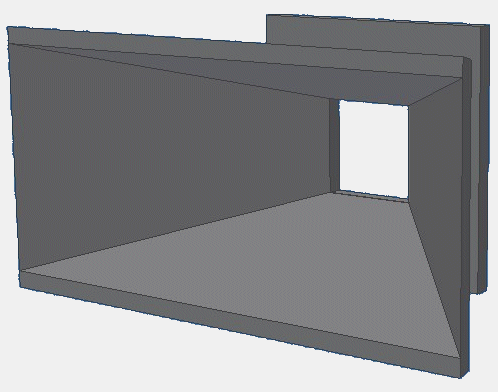
Computer Model of π Midrange Horn
It's been a long time coming, but now I've got a pretty good design nailed down. It is inexpensive and extremely simple to build. And we will be offering them complete or in flat-pack kit form which makes them even easier to build.
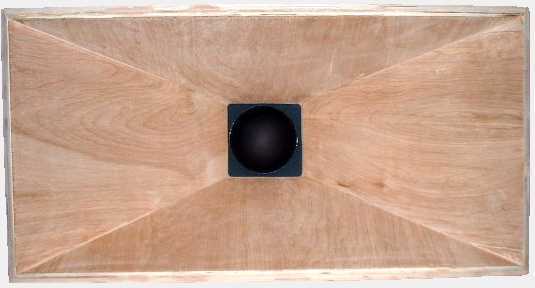
Front View of Maple π Midrange Horn
Horn Basics
The horn covers the 200Hz to 2kHz band and has 105dB/W/M sensitivity. Maximum power is 300 WRMS, so maximum SPL is over 125dB. Actual response depends on placement, but it is intended primarily as a midrange horn subsystem for three-way (and four-way) π cornerhorns, so corner placement is normal. In this application, the horn is smooth down to below 200Hz, almost to 150Hz.
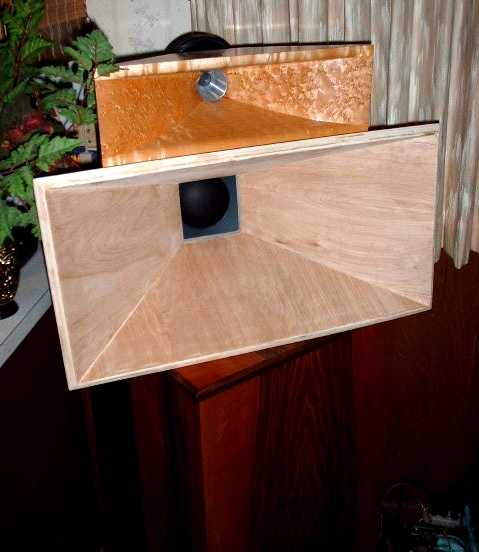
Seven π cornerhorn with midrange horn and Martinelli tweeter horn
Response is good to 2kHz, and then drops about 5dB and remains at this reduced shelf for almost an octave, to 3.5kHz. This is due largely to breakup modes in the driver. Both the Eminence Delta 10 and the JBL 2012 have rising response that peaks in the region above 2kHz. What occurs here is that the cone begins to flex making ripples in the surface of the cone. These cone surface movements are decoupled from the heavier moving assemblies so it's like having another much lighter cone driving the horn. This makes a second area of response that increases output from the horn above 1kHz.
In some applications, this output can be used making the horn capable of output to 3500Hz. Other applications will want to rolloff the region above 2kHz, and I've found that this can be done with a simple 1mH series coil. This is the same "Pseudo Butterworth" arrangement I've used in the past, and the addition of a 1mH coil does very little to affect horn response below 2kHz. It just shaves the peak between 2kHz and 4kHz, attenuating that region and preventing it from increasing horn output in this range.
Here are the plans:
|
|
|
|
| Cabinets [message #44368 is a reply to message #44366] |
Mon, 12 April 2004 01:02   |
 |
 Wayne Parham
Wayne Parham
Messages: 18984
Registered: January 2001
|
Illuminati (33rd Degree) |
|
|
Cabinets
Some of the places where this horn will be used are on top of π cornerhorns, Klipschorns and Klipschorn clones and other speaker systems where a high-quality full-vocal-range horn is required. Some of the intended cabinet designs are shown below, and of course, many others are possible.
A simplified midhorn cabinet is shown above. The horn is enclosed in a cabinet, and the rear chamber is lined with R13 or other suitable absorbent stuffing material. The size and shape is arbitrary, as long as the rear chamber exceeds 0.35ft3; It just needs to be big enough to surround the driver and that's all. Since the horn is often used on cornerhorns, it makes sense to have a shape that is suitable, so trapezoids and shapes like shown above might be better than rectangular cabinets. But it is really a matter of aesthetics.
One thing that I think is important is that the driver mount panel also be used as a physical support. It should be extended to meet the top and/or bottom of the cabinet.
A version of the cabinet can be made to fit Klipschorns and Klipschorn clones. The dimensions are shown below.
As I mentioned earlier, we plan to offer this horn as a completed assembly and as a flat-pack kit. Prices aren't set yet, but we'll do that pretty soon and add them to the shopping cart. I think they'll be something like $100.00 each for basic MDF and $150-$200 for various fine woods. Flat pack kits make assembly easy, since they are already cut-out and ready to assemble. We also have the drivers in stock and our prices are competitive, cheaper than Parts Express and places like that.
|
|
|
|
| Implementation [message #44369 is a reply to message #44366] |
Mon, 12 April 2004 01:03   |
 |
 Wayne Parham
Wayne Parham
Messages: 18984
Registered: January 2001
|
Illuminati (33rd Degree) |
|
|
Implementation
The simplest implementation of the horn is as a full vocal range driver. When used in this way, it will provide output from 250Hz to 3.5kHz in free space, or 150Hz to 3.5kHz quarter-space or eighth-space, such as when used indoors. For public address or speech amplification, this is really all you need.
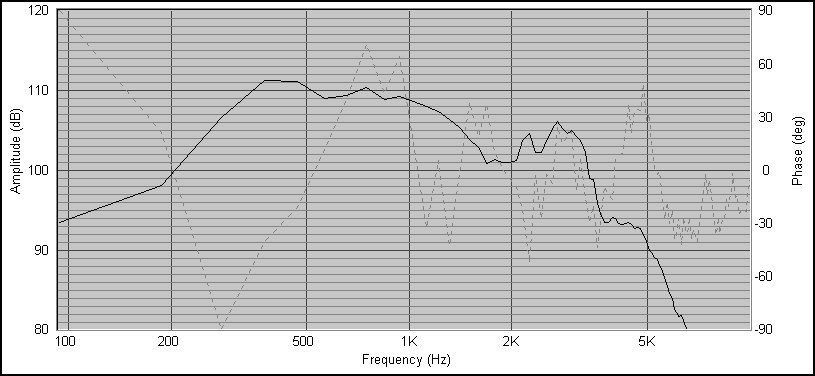
Response in Freespace
Response is down -3dB at 300Hz and 1.2kHz, -6dB at 250Hz and 1.6kHz and -10dB at 200Hz and 3.5kHz. In room boundaries extend low frequency performance and make the overall response curve smoother. You can expect lower rolloff points to shift an octave lower in room corners.
The intended application is to use existing 1.6kHz crossovers in many π Speakers models. As such, output above 2kHz is not wanted. So adding a 1mH coil in series shaves the 3kHz peak without doing much of anything else.
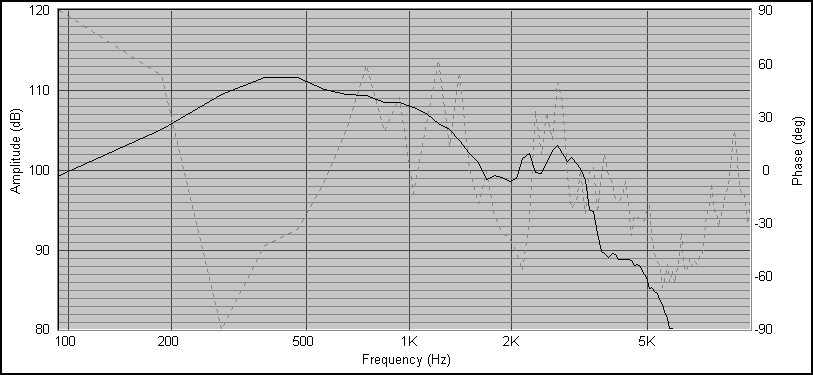
Response in Freespace, with 1mH series coil added
As you can see, the coil reduces the peak about 3dB, just enough to drop the overtone region a bit. It has absolutely no effect on horn output below 2kHz. The tweeter will cover the range above 1.6kHz so midrange output above 2kHz is unwanted.
Midrange horn output is as high as the compression driver, so this leaves us with a couple of configuration options. The tweeter crossover's compensation cable assembly can be removed and a shunt damper installed on the tweeter instead. A damping resistor is required to prevent the voice coil from peaking with crossover capacitance. But level matching attenuation could be removed, allowing the tweeter horn and the midrange horn to generate 105dB/W/M.
But that would leave us with a couple of problems to solve by other means. Without top-octave compensation, the tweeter will begin to rolloff at 4kHz and EQ will be required. Also, the midrange horn will rolloff around 200Hz or 300Hz, depending on its placement. So unless the woofer is capable of 105dB/W/M, it will need some EQ as well.
Leaving the tweeter compensation in place gives the following response curve:
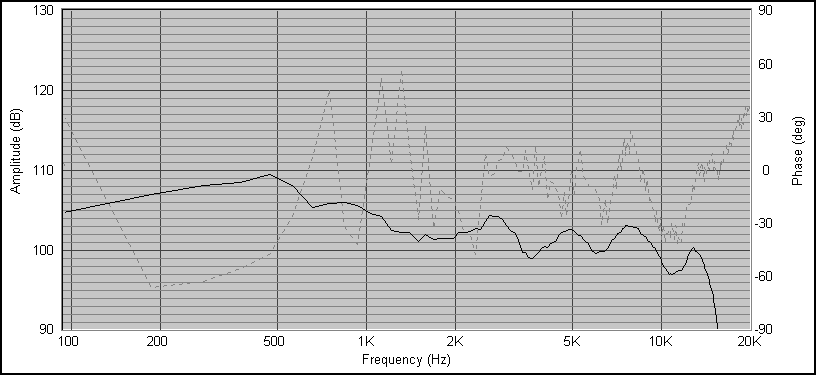
Midhorn with 1mH series coil, tweeter with 1K6a010dB crossover
As you would expect, tweeter response is extended but it is also shelved at a reduced level. It actually sounds pretty good this way, and some audiophiles might prefer it. But my solution is to pad the midrange to match, using a 4 ohm series resistor followed by 8 ohms in shunt.
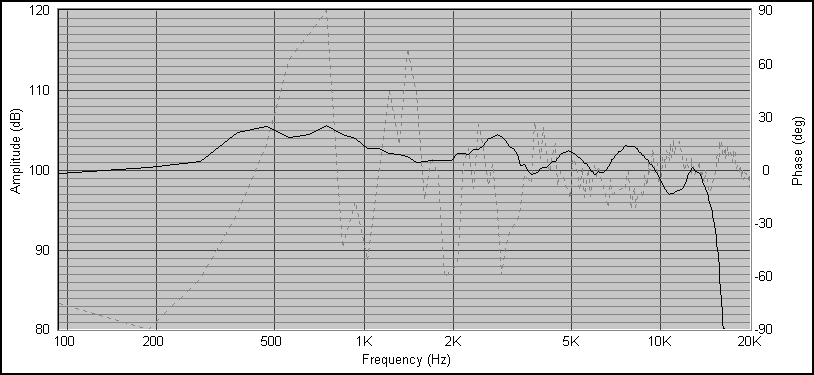
Midhorn with 1mH series coil and attenuator, tweeter with 1K6a010dB crossover
This brings sensitivity down to 98dB/W/M, but it does offer some advantages. Obviously, the response curve is made flatter. Also, the system is well-damped by the padding resistors, and the amplifier sees a more resistive load. The amplifier is presented a load that is gradually rising through the midrange and overtone region but that is mostly resistive. It sounds very, very nice.
Now for the crossover to the woofer. The common-sense thing would be to replace the woofer crossover components, dropping the lower crossover point down to 200Hz for a cornerhorn or 300Hz for bass-reflex or freestanding horn. That's a good approach. The wavelength of 200Hz is over 5 feet, so unless the woofer and midrange are very far apart, you'll want the woofer and midrange in phase electrically. That ensures that the midrange and woofer are phased properly at the crossover point.
I connected the midhorns to an existing pair of seven π cornerhorns this way. I connected everything up as is described here, with the midrange padded down to match the tweeter, and the tweeter connected in reverse polarity. I am very pleased with this system; It sounds very good and well balanced. You gain all the benefits of reduced midrange distortion and flatter response from the front midhorn, and you maintain the room filling richness, the sort of homogenous uniformity of the reverberent field that only the cornerhorn configuration and it's uniform 90° dispersion can provide.
For any of you that might want to get started now, it's relatively easy for you to connect everything up as I did. If you want, you can swap the woofer crossover components to shift the lower crossover point down to 250Hz. Or you can order the π 250/1K6 crossover, because it's already made this way and ready to go.
|
|
|
|
| eight π [message #44370 is a reply to message #44366] |
Mon, 12 April 2004 01:04   |
 |
 Wayne Parham
Wayne Parham
Messages: 18984
Registered: January 2001
|
Illuminati (33rd Degree) |
|
|
eight π Loudspeaker
An interesting application of this midrange horn is to make a mini-VOTT, which I'm calling the eight π loudspeaker. Since the rear chamber is made arbitrarily large, it occured to me that it could be ported, made 5.5ft3 or so and house an Alpha 10.
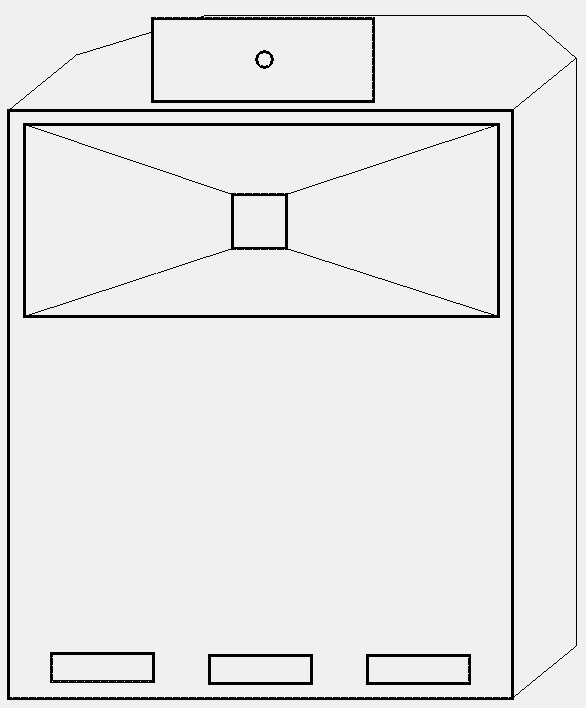
Conceptualized eight π Loudspeaker
It's intended to be used in corners, but can just as well be put against a single wall. Placement isn't quite as critical as a cornerhorn because it isn't a cornerhorn. The tweeter would be a PSD2002 on a 1kHz horn, and it would be mounted with the mouth edge flush with the midhorn. If you have the means, the wood horn is nice but on a budget, the H290 would work perfectly and could be housed in a nice small subenclosure that would look really nice. There's lots of ways to make this work well and look good too.
I haven't done any testing of this yet, but I did bolt the midhorns up to a pair of tower two π speakers. It was really impressive. The bass is incredible, and the midrange is nice too.
I like the midrange from the Alpha 10's in the two π, but their weakness is in the 2kHz to 4kHz overtone region. The coil in the two π's reduces some of the Alpha 10's harshness there, but the eight π configuration really makes 'em sing. It's amazing what this little forty dollar midwoofer will do.
I'm really excited about this new little speaker. It isn't intended to outperform the higher-priced cornerhorns or anything like that, but it does have a place in the lineup somewhere near the Thermionic and Theater Series cornerhorns. It should be a good performer with classic looks. The cabinetmakers can have a field day with two-tone and forties style finishes.
|
|
|
|
| Re: Implementation [message #44371 is a reply to message #44369] |
Mon, 12 April 2004 03:08   |
 Adrian Mack
Adrian Mack
Messages: 568
Registered: May 2009
|
Illuminati (1st Degree) |
|
|
|
Looks cool. I think the 1.6KHz crossover is the best choice. Off-axis response above that probably drops like a rock especially once the drivers in breakup modes, good idea having the compression driver take over instead. Have you taken the 2nd, 3rd and 4th graphs indoors or something? They all seem to have a lot more response below 300Hz than the 1st one does. Is the rear facing midrange you talk about just the woofer in the cornerhorn's? Did you run into problems with the edge of the cone in the midrange horn slamming into the mounting plate? This was a problem I found in my horn at high levels. It was clear as daylight to hear it when excursion was high at high SPLs, awful sound it makes. I had to add a ring between driver and mounting plate, and add another piece between cone and front chamber to bring the volume back down again that the ring displaced in the front chamber. Or you could just route a circle groove in the mounting plate where the edge of the cone meets instead. Good job!
|
|
|
|
| Re: Implementation [message #44372 is a reply to message #44371] |
Mon, 12 April 2004 03:39   |
 |
 Wayne Parham
Wayne Parham
Messages: 18984
Registered: January 2001
|
Illuminati (33rd Degree) |
|
|
|
All graphs were done outdoors, and they all varied a little bit from sample to sample. I always take at least three measurements and look for consistency. But I've also always considered tests like this to be a bit ambiguous because it is really sort of a budget test. Please don't consider these datasets to be anything but tools to help explore the design. The rear-facing midrange used in the 1980's seven π loudspeakers were JBL 2105's, which were also used as front-facing midrange drivers. They were a 5" cone midrange, and there were sets for the front and rear installed in that model. Two-way versions develop all midrange from the driver in back, so the addition of a forward-facing midhorn will cause the speaker to have front and rear midrange output unless the driver in back is crossed over lower. A 1/4" or 3/8" mounting spacer ring is an excellent idea. The additional front chamber volume won't hurt and it will ensure that the cone can't strike the mounting plate. For those that have routers, it might be just as good to route out that much area around the driver on the plate, maybe even just at the edge and back towards the center for an inch or so. The only part that might strike at high excursions is the surround and maybe the edge of the cone.
|
|
|
|
| Re: Implementation [message #44373 is a reply to message #44372] |
Mon, 12 April 2004 05:00   |
 Adrian Mack
Adrian Mack
Messages: 568
Registered: May 2009
|
Illuminati (1st Degree) |
|
|
|
Yeah, I know, they're still useful though. I like that measurements page you've linked, I can finally see what the difference is between the PSD2002 and 2426 now. Seems the PSD2002 goes the highest and is smoothest on H290, and pretty good on JBL 2370, dont know why I'm even mentioning it, just been something I've wondered about for awhile.
|
|
|
|
|
|
| Re: Implementation [message #44375 is a reply to message #44374] |
Mon, 12 April 2004 06:51   |
 Adrian Mack
Adrian Mack
Messages: 568
Registered: May 2009
|
Illuminati (1st Degree) |
|
|
|
Actually I got the 2225's in mine. I was working on the speakers today actually, because I had slacked off for a bit :P I've had other stuff on though which has taken up some of my time so its not all just being lazy! Going to the hardware store tomorow to see what sort of finishing they have. I hope its not too much, I want to get Tung Oil, the name sounds expensive. I gotta get some casters too, the boxes really ARE heavy and difficult to shuffle around. I need to do the correct crossovers still, it's just half done make-shift stuff at the moment. It's well into Autumn now, temperatures are a lot cooler. But we had zero rainfall all last month, something which hasn't happened since a decade or two, show's the effects of global warming I guess. Not good for our water supplies, we have water restrictions in the summer each year and for the first time we now have them through winter as well. I was rummaging through the storeroom today and found a pair of old 8" Rola vintage drivers I had forgetten about. Just for fun I threw them on the tractrix horns I'm not using. They sounded OK actually, but definitly no where near as clean as the Alpha 6 conical horn. I might take do some frequency response measurements for fun on it, cuz I got a pair of them doing nothing. If its anything interesting I'll post some pics of the drivers and FR curves, see what I can do with a driver with no TS parameters and about 25-30 years old :P
|
|
|
|
Goto Forum:
Current Time: Wed Dec 03 17:47:12 CST 2025
|







